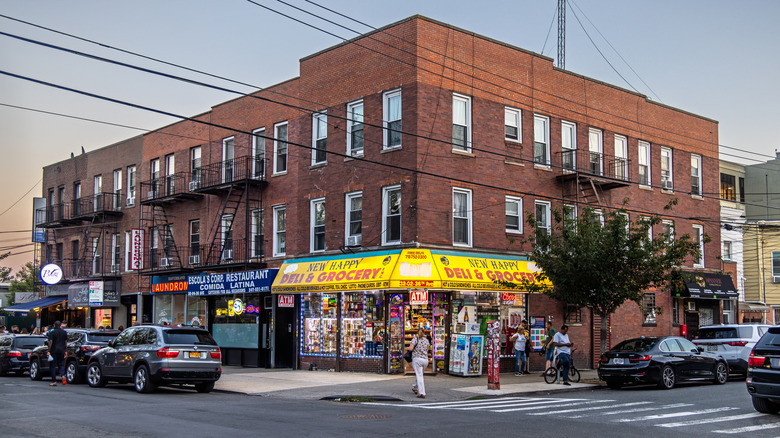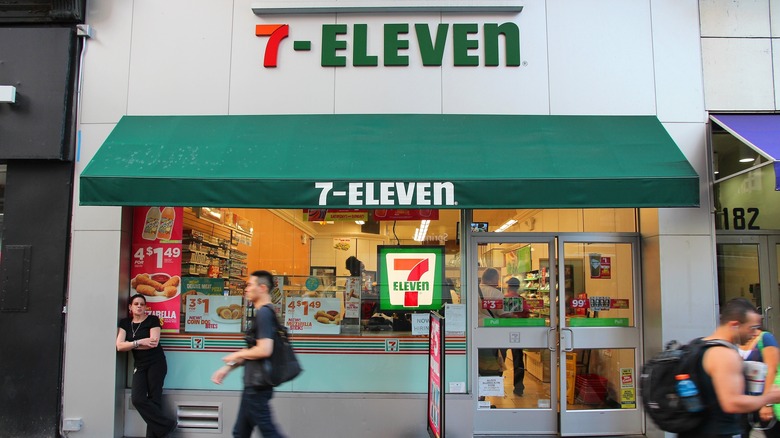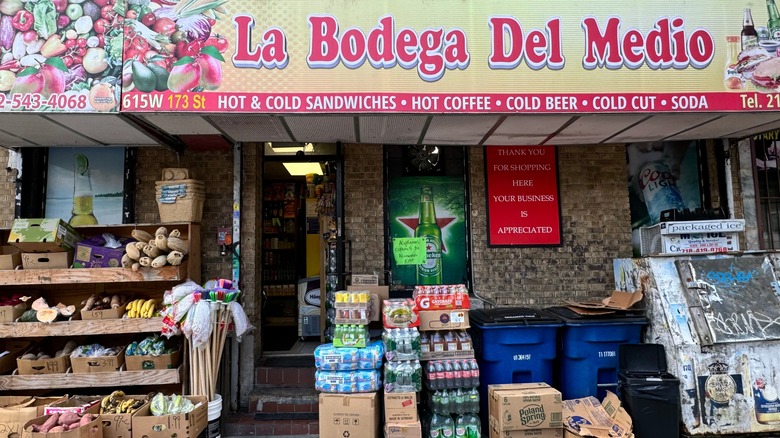Is A Bodega The Same Thing As A Convenience Store?
Bodegas are fixtures in New York City and its boroughs. Nearly every street corner seems to have one. This is a slight exaggeration, but just barely. The United Bodegas of America estimates that around 13,000 bodegas exist in New York City. And yes, given that you can buy incidentals from your neighborhood bodega on your way home from work, they are a type of convenience store. However, state-spanning chains like Circle K or Maverik they are not, though by some ways of thinking, the line between the two might be kind of blurred, despite bodegas having been in a fixture in New York City since the 1920s, particularly in Puerto Rican neighborhoods where they first opened.
In the Big Apple, a bodega is the place where you'll find packs of Juicy Fruit gum, fresh flowers, a carton of milk, and, oh yes, wine, too. Some people do refer to the bodegas as convenience stores, and indeed, in Cuba, the word "bodega" has come to mean just that. However, "bodega" traditionally means "warehouse" or "wine cellar" in Spanish. This is one of the reasons why you might find bottles of wine for your next dinner party at one (though it's not a requirement for them to carry vino).
The milk, on the other hand? In New York, at least, carrying milk is a requirement for a shop to be classified as a bodega, per the New York Department of Health. And while it's typical for a neighborhood bodega to sell other fresh food, it isn't necessarily any specific kind of food. In other words, the store isn't a specialized butcher or bakery, but rather a place with an assortment of convenient fare, from snacks to sandwiches. A bodega also has a max of two registers, which guarantees it stays small and local.
What is a convenience store?
The brainchild of Jefferson Green who ran an ice store called Southland Ice Dock, convenience stores got their start in 1927. Modern refrigeration as it's known now didn't exist, so every couple of days, people came into Green's store to buy ice to keep the food in their kitchen iceboxes cold.
Eventually, he started to carry some basic foods: milk, eggs, and bread. Due to the nature of his business, he was open seven days a week, 16 hours a day, so being able to offer ice as well as some fresh food was a way to set himself apart from local grocery stores. Someone in Southland Ice Dock's upper management caught onto Green's idea and decided to combine the concept of grocery stores with ice stores. The 7-Eleven convenience store franchise was born from this, as were all of the other convenience store chains around the U.S. (Maverik in 1928 and Circle K in 1951, for example). The nationwide spread of convenience stores took some time, however.
The 7-Eleven "accidentally" became a 24-hour store in 1963. There was a football game at The University of Texas at Austin. Post-game activities (and probably hunger) pulled customers into a 7-Eleven there. Things remained so busy, the clerks working in the store that night never closed the doors, which wound up creating the around-the-clock concept. When the powers that be realized that their stores could make more money (and reduce the likelihood of robbery) by staying open all night, the 24-hour-a-day model of convenience store was born.
The bodega's place in the grocery world
Also typically open past normal grocery store hours (and sometimes even 24/7), it probably goes without saying that bodegas do have a lot in common with the convenience store chains like 7-Eleven or Maverik. And given that you can buy groceries at a bodega, some might also refer to them grocery stores, though most New Yorkers typically reserve that term for larger supermarkets, like Gristedes. Bodegas even share some characteristics with delis, often offering customers a place to snag a real NYC pastrami sandwich at lunch (although Anthony Bourdain's favorite spot for the signature food was a famous restaurant). And then, as is still typical today, bodegas were family-run affairs.
In many respects, though, they're about as far from supermarkets and convenience stores chains as you can get. After all, they're hyper-local. Their atmosphere is casual and welcoming. People stop by their neighborhood bodega on the way to and from work to pick up incidentals, making time to scratch the resident mouser cat sitting in the shop's window behind the ears. A chat with the shopkeeper and other regulars on their way out of the store catches them up on neighborhood news.
It's this local, community-forward quality that really represents the biggest differences between the neighborhood bodega and a name-brand convenience store. In NYC, the Healthy Bodegas Initiative, run by the New York Department of Health, even tapped local bodegas to help promote healthy lifestyles among under-served populations in the city. Given that a bodega's customers tend to live around the corner from the stores and frequent them often, the pairing was logical. And while customers might come into their local bodega for a carton of milk, they leave with a sense of stronger community ties as well.


